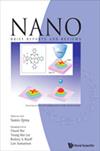Synthesis and Characterization of CdO/CdS Nanocomposite for the Degradation of Methyl Orange Dye
IF 1
4区 材料科学
Q4 MATERIALS SCIENCE, MULTIDISCIPLINARY
引用次数: 0
Abstract
CdO/CdS nanocomposites have been synthesized via the solution combustion route. These nanocomposites have been characterized in terms of XRD, FESEM, EDS, UV-visible and FTIR spectroscopy. The crystallinity and the crystallite size of the as-synthesized CdO/CdS nanocomposites were calculated from XRD, whereas the surface morphology and chemical purity were obtained from FESEM and EDS analysis. Further, all the samples were used as photocatalyst for the degradation of methyl orange (MO) dye under UV-Visible irradiation. The rate constant, [Formula: see text], was obtained by the Langmuir–Hinshelwood model. From [Formula: see text] values, it can be observed that the rate constant increases on increasing the amount of photocatalyst due to an increase in surface area. The rate constant value for CdO/CdS nanocomposite annealed at 615[Formula: see text]C was found to be very low, which may be largely due to loss in crystallinity at this higher temperature. Further, we compared our results with those reported in the literature and it was observed that CdO/CdS nanocomposites act as a better photocatalyst than others.降解甲基橙染料的CdO/CdS纳米复合材料的合成与表征
采用溶液燃烧的方法合成了CdO/CdS纳米复合材料。利用XRD、FESEM、EDS、uv -可见光谱和FTIR光谱对复合材料进行了表征。用XRD计算了合成的CdO/CdS纳米复合材料的结晶度和晶粒尺寸,用FESEM和EDS分析了表面形貌和化学纯度。此外,所有样品都用作光催化剂,在紫外-可见照射下降解甲基橙(MO)染料。速率常数,[公式:见文本],由Langmuir-Hinshelwood模型得到。由[公式:见文]的值可以看出,随着光催化剂用量的增加,由于表面积的增加,速率常数也随之增加。在615℃下退火的CdO/CdS纳米复合材料的速率常数值非常低,这可能主要是由于在这个较高的温度下结晶度的损失。此外,我们将我们的结果与文献报道的结果进行了比较,发现CdO/CdS纳米复合材料比其他材料具有更好的光催化剂作用。
本文章由计算机程序翻译,如有差异,请以英文原文为准。
求助全文
约1分钟内获得全文
求助全文
来源期刊

Nano
工程技术-材料科学:综合
CiteScore
2.10
自引率
0.00%
发文量
95
审稿时长
1.6 months
期刊介绍:
NANO is an international peer-reviewed monthly journal for nanoscience and nanotechnology that presents forefront fundamental research and new emerging topics. It features timely scientific reports of new results and technical breakthroughs and also contains interesting review articles about recent hot issues.
NANO provides an ideal forum for presenting original reports of theoretical and experimental nanoscience and nanotechnology research. Research areas of interest include: nanomaterials including nano-related biomaterials, new phenomena and newly developed characterization tools, fabrication methods including by self-assembly, device applications, and numerical simulation, modeling, and theory. However, in light of the current stage development of nanoscience, manuscripts on numerical simulation, modeling, and/or theory only without experimental evidences are considered as not pertinent to the scope of NANO.
 求助内容:
求助内容: 应助结果提醒方式:
应助结果提醒方式:


